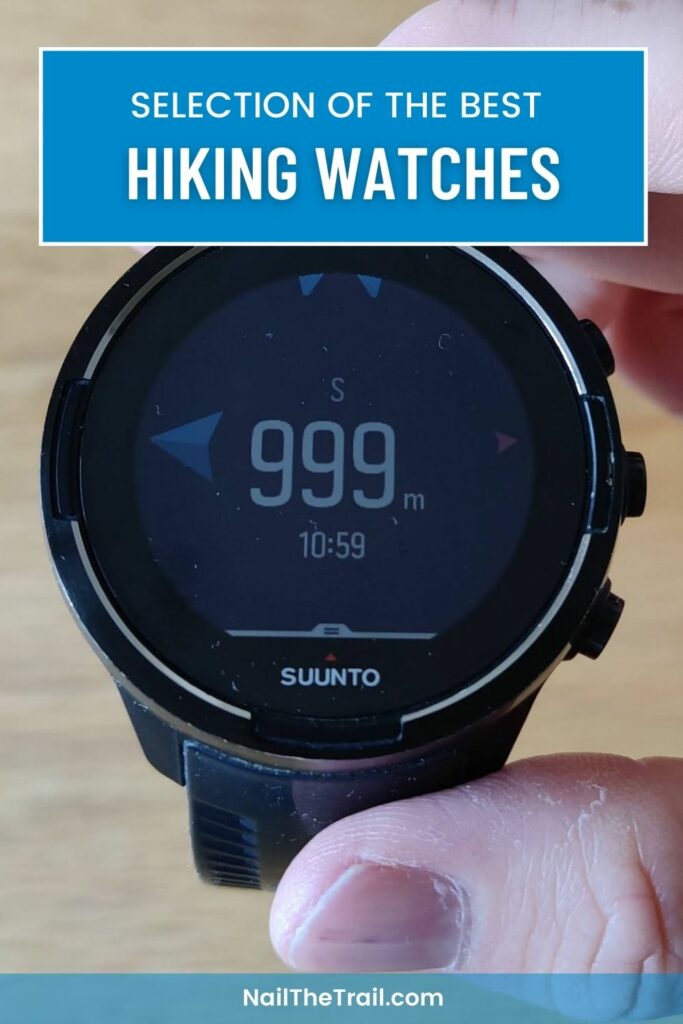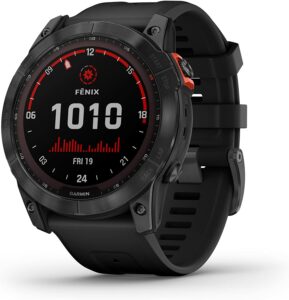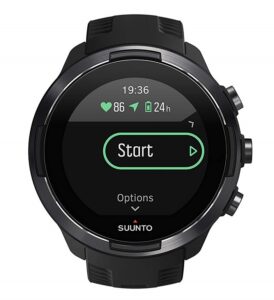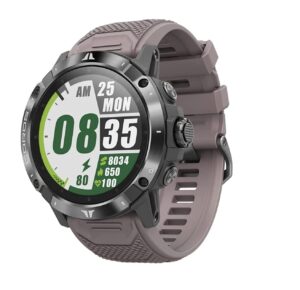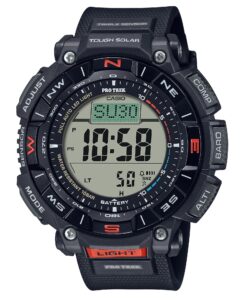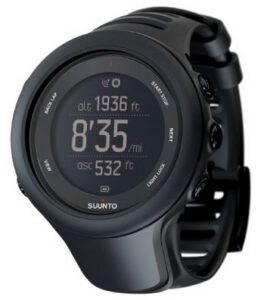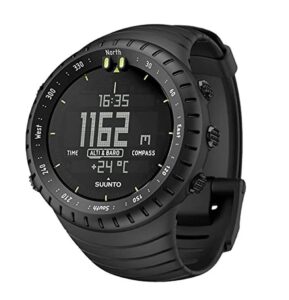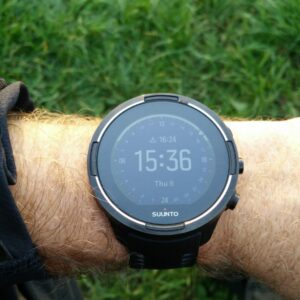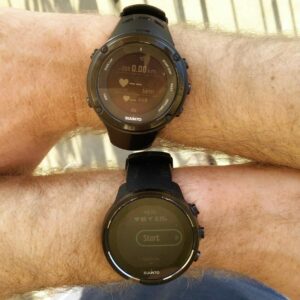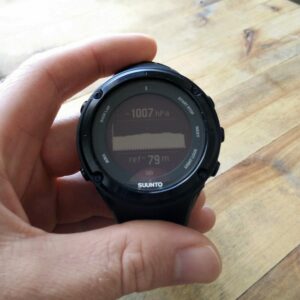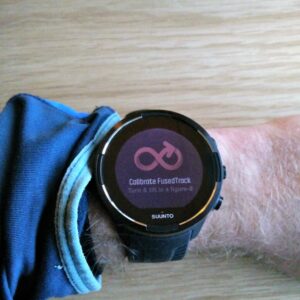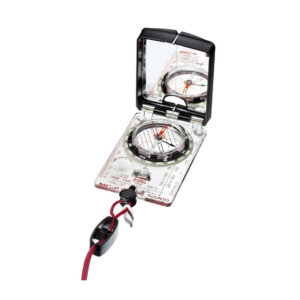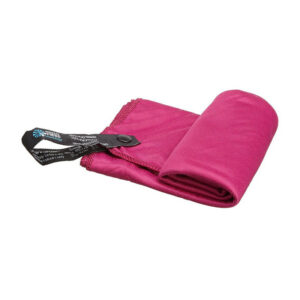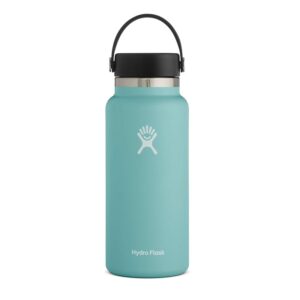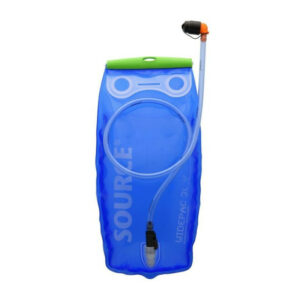A good hiking watch doesn’t only show time and date but it also provides us with crucial information for our outdoor adventures such as current altitude, location, air pressure and sunrise/sunset times. This information helps us with navigation, planning, and weather prediction. Hiking watches are incredibly popular these days, and the companies behind them are making significant progress in combining design with useful technology. In this selection, we’ve included four GPS watches and two watches without GPS (one of which is listed in the honorable mentions section at the bottom).
While GPS certainly has its advantages, some do prefer a watch without GPS because hiking watches without GPS offer a longer battery life, a less complicated user interface, and are also more budget-friendly. Nevertheless, we’re big fans of GPS watches because they’re so useful for navigation along the trails. All the watches in this selection are equipped with a compass, altimeter and barometer – features that we consider essential for activities such as hiking, trekking, mountaineering, and backpacking. Since new models of hiking watches are regularly released, we continuously update this selection to always recommend you the best products available. Nevertheless, below, you’ll find some tried-and-true classics that haven’t been beaten in terms of functionality – yet.
Updated Content
We regularly update our reviews and selections to always recommend you the best products on the market.
Expert Selections
We only list top-tier products. Read how our selections of best hiking products differ from others here.
Links
We use affiliate links and may receive a small commission on purchases at no extra cost to you.
1. Our Hiking Watches Picks
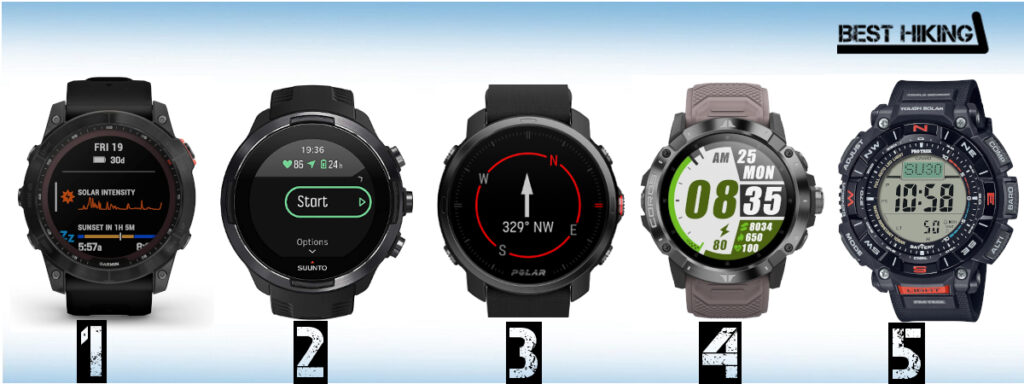
Best Hiking Watches List
2. Comparison of Hiking Watches
| Feature/Product | Garmin Fenix 7X Solar | Suunto 9 Baro | Polar Grit X | Coros Vertix 2 | Casio Pro Trek PRG-340 |
|---|---|---|---|---|---|
| Weight | 3.39 oz. | 2.86 oz. | 2.26 oz. (PRO model – 2.78 oz) | 3.2 oz. | 1.9 oz. |
| Weight (Metric) | 96 g | 81 g | 64 g (PRO model - 79g) | 91 g | 54 g |
| Case Size | 2.0 x 2.0 x 0.6 in. | 2.0 x 2.0 x 0.7 in. | 1.9 x 1.9 x 0.5 in. | 2.1 x 2.1 x 0.6 in. | 2.2 x 2.0 x 0.6 in. |
| Case Size (Metric) | 5.1 x 5.1 x 1.5 cm | 5.2 x 5.2 x 1.7 cm | 4.7 x 4.7 x 1.3 cm | 5.3 x 5.3 x 1.5 cm | 5.5 × 5.2 × 1.5 cm |
| GPS | Yes + GLONASS & Galileo | Yes + GLONASS & Galileo | Yes + GLONASS, Galilelo & QZSS | Yes + QZSS, GLONASS, Galileo & BeiDou | No |
| Display Type | Full-color MIP | Color Touch Screen | Color Touch Screen | Color Touch Screen | Dynamic Duplex LCD |
| Glass Material | Power Glass (also available with Sapphire glass) | Sapphire Glass | Laminated Gorilla Glass; PRO model – Sapphire Glass | Sapphire Glass | Mineral Glass |
| Strap Material | Silicone, leather, titanium or nylon | Silicone | Silicone, leather or textile | Silicone/Nylon | Bioplastic |
| Water Resistance | 100 m | 100 m | 100 m | 100 m | 100 m |
| Battery | Rechargeable lithium-ion | Rechargeable lithium-ion | Rechargeable lithium-ion | Rechargeable lithium-ion | Solar Rechargeable Battery |
| Battery Life | Up to 37 days in time mode | 2 weeks in time mode | 1 week in time mode with continuous HR tracking | 8 weeks in time mode | 7 months with normal use without exposure to light after charge |
| Altimeter | Yes (GPS and Barometric) | Yes (GPS and Barometric) | Yes (GPS and Barometric) | Yes (GPS and Barometric) | Yes (Barometric) |
| Barometer | Yes | Yes | Yes | Yes | Yes |
| Thermometer | Yes | Yes | Yes | Yes | Yes |
| Compass | Yes | Yes | Yes | Yes | Yes |
| Sunrise and Sunset Times | Yes | Yes | Only Polar Grit X Pro | Yes | Yes |
| Storm Alarm | Yes | Yes | No | Yes | Yes |
| Bluetooth | Yes | Yes | Yes | Yes | No |
| Smartphone Notifications | Yes | Yes | Yes | Yes | No |
| Vibration Alerts | Yes | Yes | Yes | Yes | No |
| Heart Rate Belt Support | Yes | Yes | Yes | Yes | No |
| Wrist Heart Rate | Yes | Yes | Yes | Yes | No |
| GPS Navigation | Yes | Yes | Yes | Yes | No |
| GPS Tracking | Yes | Yes | Yes | Yes | No |
| Track Back | Yes | Yes | Only Polar Grit X Pro | Yes | No |
| Planning Software | Garmin Connect | Suunto App | Polar Flow | Coros App | None |
| Mobile App | Yes (Garmin Connect) | Yes (Suunto App) | Yes (Polar Flow) | Yes (Coros App) | None |
3. The Selection
1. Garmin Fenix 7X Solar
Suitable for:
- Hiking
- Mountaineering
- Trekking
- Climbing
- Cycling
- Swimming
- Running
- Backpacking
- Everyday use
The Garmin Fenix 7X Solar watch replaced the highly popular Garmin Fenix 6 in 2022, and we were excited to explore its features. The Fenix 7X is essentially a Smartwatch with a high-resolution color display tailored for harsh outdoor conditions. The watch boasts robust materials, with a stainless steel bezel and a Sapphire glass lens (Sapphire model only), providing excellent abrasion resistance and durability. We’re really glad that watch’s elegance doesn’t diminish its functionality, making it suitable even for formal occasions like business meetings. Equipped with a 3-axis compass, altimeter, barometer, and thermometer, the watch ensures we have essential data for our outdoor pursuits. For more precise temperature readings, we can connect it to an external temperature sensor, the Garmin Tempe. The compass and altimeter are calibrated automatically via GPS.
The GPS functionality opens up a plethora of features, such as automatic time setting based on our location, navigation capabilities (routes and POIs), and activity tracking. Detailed information about each activity is easily accessible through the Garmin Connect app. The watch’s customization options include personalized apps, widgets, and unique watch faces. Synchronization with a smartphone allows us to receive texts, alerts, emails, and other notifications conveniently. Additionally, the watch supports topographic maps and music playback via Bluetooth headphones. It comes in two models (Standard and Solar) and three different sizes: 42 mm/1.7 in, 47 mm/1.9 in, and 51 mm/2.0 in. The Solar model, featuring a solar charging lens, extends the battery life significantly. All Solar models are available with or without the Sapphire glass lens, giving us options to suit our preferences. We think that the Fenix 7X is indeed the best hiking watch currently on the market.
Pros:
- Display
- Features
- Supports apps
- Offers customization
- Smartphone synchronization
- GLONASS/Galileo support
- Design
- Vibration alerts
Cons:
- Pricy
Video

2. Suunto 9 Baro
Suitable for:
- Hiking
- Mountaineering
- Trekking
- Climbing
- Cycling
- Swimming
- Running
- Backpacking
- Everyday use
The Suunto 9 Baro watch is truly an incredible timepiece, and we believe it can easily compete with the Garmin Fenix 7X Solar mentioned above. The Suunto 9 Baro watch comes equipped with a stainless-steel bezel and a vibrant color touch screen. What we appreciate is the inclusion of buttons, allowing us to easily use the watch even with the gloves. Loaded with features, the watch includes GPS, altimeter, barometer, thermometer, and compass. Navigating trails with the watch is very easy as the waypoints and GPX routes can simply be imported to the watch from the Suunto app which also allows you to easily plan routes before your hike. Furthermore, you can find existing routes from other Suunto app users and import them to your own watch – not least by using the Heatmap feature which shows popular routes within a given area. Read how we use Suunto 9 watch for navigation in our article here.
In addition to planning, the Suunto app also offers a complete overview of your workouts, since a calendar shows the workouts by parameters such as duration, distance, burned calories etc. The Suunto 9 watch can also track distance, find a route back to your starting point, show current speed and much more. It comes with a wrist-based heart rate monitor (read what we like about wrist HRs here) which eliminates the need for wearing a heart rate belt. Bluetooth connectivity allows you to connect the watch to your Smartphone and receive notifications from the phone on your watch. Equipped with Sapphire glass for excellent abrasion resistance, the Suunto 9 Baro falls short compared to the Garmin Fenix 7 Solar as it doesn’t support maps and music. Also, the battery is not solar rechargeable, but it compensates with a superior GPS antenna, providing more accurate tracking. All in all, we were really happy with Suunto 9 Baro watch. Read our full review of Suunto 9 Baro watch.
Pros:
- Bluetooth
- Supports apps
- Suunto app
- Smartphone synchronization
- Multisport mode
- Design
- GLONASS/Galileo support
- Vibration alerts
- Display
Cons:
- /
Where to buy?
Also available at:
Video

3. Polar Grit X
Suitable for:
- Hiking
- Mountaineering
- Trekking
- Climbing
- Running
- Everyday use
- Backpacking
The Polar Grit X watch watch entered the scene in early 2020, and we were immediately drawn to its appealing design and advanced features. The watch became a quick favorite among hikers, backpackers, and mountaineers. Similar to the Suunto and Garmin watches we discussed earlier, the Grit X is a multisport watch with a robust design meeting military standards for durability (MIL-STD-810G). It comes packed with GPS, altimeter, barometer, thermometer, and digital compass. The watch’s navigation function can be activated in various sport modes, and importing routes is a seamless process through the Polar Flow platform, available as both a web application and a smartphone app. We also really like that the Polar Flow platform can be connected to the popular Komoot app which means that your routes from Komoot will automatically sync to your watch.
The Polar Grit X watch is available in three different versions: Grit X, Grit X Pro and Grit X Pro Titan. The Grit X Pro model comes with a scratch resistant Sapphire glass lens and has several additional features. It supports “outdoor dashboard” which shows altitude chart, compass, coordinates and sunrise/sunset times. The basic model shows altitude chart and compass only while you are tracking your activity. The Pro model also supports track back feature and shows elevation profiles of imported routes. Performance and recovery tests are also only available in the Pro and Titan models. The Titan model has all features of the PRO model but is made of even sturdier and lighter materials. We think that the Polar Grit X is an amazing outdoor watch but when we compare it to Suunto 9 Baro and Garmin Fenix 7X we feel it lacks some features such as storm alarm and atmospheric pressure chart which is useful for predicting the weather. Nevertheless, we should also point out that it is a less expensive watch.
Pros:
- Bluetooth
- Smartphone synchronization
- Multisport mode
- Design
- GLONASS/Galileo support
- Vibration alerts
- Display
- Precise wrist heart rate monitor
- Komoot integration
Cons:
- No storm alarm (might change with future updates)
- No barometer chart for predicting the weather (might change with future updates)
Video

4. Coros Vertix 2
Suitable for:
- Hiking
- Mountaineering
- Trekking
- Cycling
- Climbing
- Swimming
- Running
- Backpacking
- Everyday use
The Coros Vertix 2 watch hit the shelves in August 2021, and it swiftly gained popularity among athletes and sports enthusiasts, including us. This multisport watch isn’t just for intense workouts. It packs numerous features that cater to hiking and mountaineering. Connecting to five satellite systems simultaneously, it delivers precise and rapid GPS tracking. Another advantage is the support for dual-frequency satellite communication, enhancing the GPS signal further. Alongside the essentials like altimeter, barometer, thermometer, and compass, the Coros Vertix 2 goes the extra mile with features like storm alerts, phone notifications, and the ability to pair with external devices such as heart rate belts and Insta360 cameras.
Crafted from highly durable materials, the Coros watch boasts a titanium case and bezel, while the screen is protected by Sapphire glass. We really like this robust construction which ensures that you can engage in activities like climbing without worrying about scratches. The generous 1.4-inch screen displays a wealth of information – up to 8 different metrics during activities. What truly makes the Coros Vertix 2 stand out is its impressive battery life. Lasting up to 60 days in time mode and a whopping 140 hours with GPS tracking enabled, it’s a reliable companion for extended outdoor adventures.
For outdoor enthusiasts like us, the Coros Vertix 2 proves to be an excellent choice. However, it’s worth noting that we found the process of importing GPX routes more complicated compared to the watches mentioned earlier because the Coros app lacks a route planning feature. Despite this, the watch’s overall performance and durability make it a compelling option for those who love outdoor activities.
Pros:
- Bluetooth
- Smartphone synchronization
- GPS performance
- Support offline maps
Cons:
- Tricky to import GPX routes
Video

5. Casio Pro Trek PRG-340
Suitable for:
- Hiking
- Mountaineering
- Trekking
- Backpacking
- Everyday use
The Casio Pro Trek PRG-340 is our go-to non-GPS watch, offering durability and a host of useful features for our hiking adventures. This trusty timepiece is equipped with a digital compass, barometer, altimeter, and thermometer. The standout feature is its solar-rechargeable battery, providing an impressive 7 months of normal use without light exposure after a full charge and an incredible 27 months when stored in total darkness with power save mode. With this battery life, we can confidently say goodbye to unexpected battery surprises. Bidirectional calibration ensures that accurate timekeeping is a constant.
The compass in our Casio watch is not just functional but versatile, supporting magnetic declination correction and featuring a bearing memory. The barometer adds an extra layer of utility, displaying a trend graph to help us predict weather changes. The pressure change indicator serves as a valuable warning for significant atmospheric alterations. Alongside these advanced features, the watch includes more basic functionalities such as a stopwatch, countdown, calendar, and up to five daily alarms. The Casio Pro Trek PRG-340 is our great companion, satisfying every hiker among us who doesn’t require a GPS watch.
Pros:
- Light-weight
- Size
- Price
- Band and case made out of environmentally friendly biomass plastics
Cons:
- Without GPS
- Can’t be paired with a heart rate belt
4. Honorable Mentions
The products listed here were once included in our best five selection but as newer and better products were released we moved them into this section.
Suunto Ambit 3 Peak
Suitable for:
- Hiking
- Mountaineering
- Trekking
- Cycling
- Climbing
- Swimming
- Running
- Backpacking
- Everyday use
The Suunto Ambit 3 Peak watch stands out as another excellent choice for us hikers and mountaineers, offering a solid blend of functionality and durability. While its display may be less sophisticated (matrix) compared to some watches mentioned earlier, and it doesn’t support GLONASS, the Ambit 3 comes with the advantage of being less expensive and having a slightly more user-friendly interface. It’s equipped with GPS, altimeter, barometer, thermometer, and compass. The watch’s high-performance GPS antenna ensures excellent reception, supporting navigation and tracking seamlessly. Synchronizing it with the Suunto app enhances its capabilities, allowing us to view real-time GPS data, including speed, distance, and elevation gain.
As Suunto’s first Bluetooth-compatible watch, the Ambit 3 easily connects to our smartphones, delivering incoming and missed calls, messages, and other notifications through the Suunto app (available for Android and iOS devices). Beyond its connectivity features, the Suunto Ambit 3 proves to be a reliable companion for hiking and mountaineering, offering a plethora of hiking-specific features. It’s important to note that besides the Peak version, there are three other models of the Suunto Ambit 3 watch (Ambit 3 Vertical, Ambit 3 Sport, and Ambit 3 Run). However, the features described here specifically apply to the Suunto Ambit 3 Peak watches, designed particularly for hiking and mountaineering. Additionally, some Suunto Ambit 3 Peak watches come equipped with Sapphire glass lenses, adding an extra layer of durability. We think the Suunto Ambit 3 Peak is an excellend choice if you’re on a budget and want a second hand hiking watch.
Pros:
- Bluetooth
- Supports apps
- Suunto app
- Smartphone synchronization
- GPS accuracy
- Multisport mode
Cons:
- External antenna
Where to buy?
Also available at:
Video

Suunto Core
Suitable for:
- Hiking
- Mountaineering
- Trekking
- Backpacking
- Everyday use
The Suunto Core watch is a great option for those who want a watch with numerous hiking features but not necessarily GPS. What we like about this watch is the ration between price and quality. It’s the least expensive watch in this selection but features-wise it offers a lot. It is equipped with compass, altimeter, barometer and thermometer. It switches between altimeter and barometer mode automatically (it detects if you are changing altitude) and provides you with weather information from the atmospheric pressure trend graph and trend indicator while in the barometer mode. If a storm is rising, the watch detects this, and the storm alarm goes on. The basic features of the watch are time, alarm, dual time and sunset/sunrise times. The replaceable battery lasts for approximately 1 year. Unfortunately, the Suunto Core watch is not compatible with a heart rate belt which would indeed come in handy on hiking trips. The Suunto Core watch is due to its simplicity and durability a great choice for those who want a straightforward hiking timepiece with great features. It comes in five different versions which all offer the same functionality but differ by materials and color; All Black and Regular Black (both with mineral glass lens, composite case, elastomer strap), Black/Red and Black/Yellow (both with mineral glass lens, composite case, textile strap), and Brushed Steel (Sapphire glass lens, stainless steel case, silicone strap).
Pros:
- Automatic Alti-Baro Switch
- Design
- Easy to use
Cons:
- Without GPS
- Can’t be paired with a heart rate belt
Video

5. Hiking Watch Buying Advice – What is important?
Hiking Features:
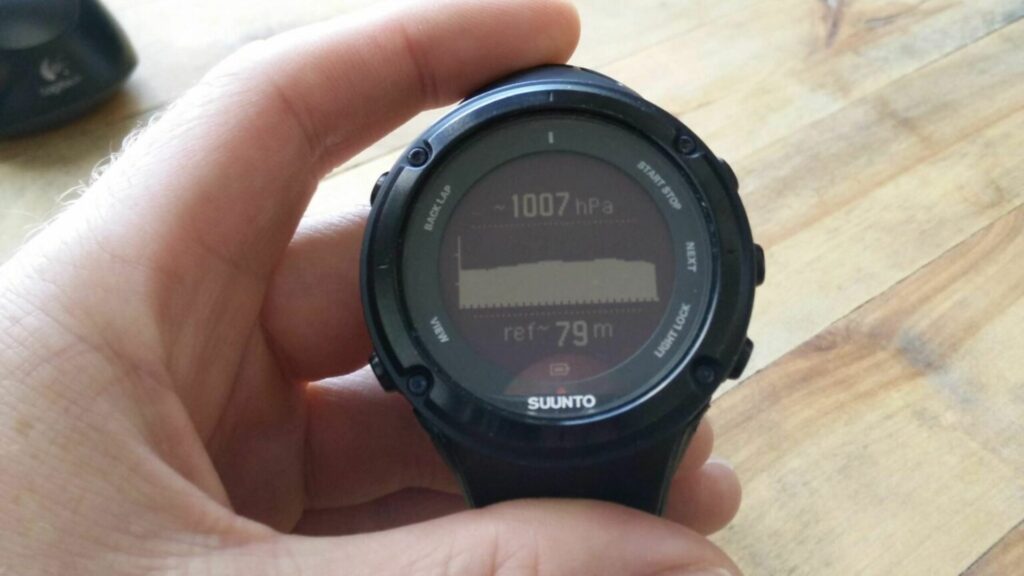
Hiking Features: Hiking watches are equipped with compass, altimeter and barometer
Every hiking watch should feature altimeter, barometer and compass functions. Watches with these features are often called ABC watches. So, why it’s so important that a hiking watch has these three features? Let’s explain.
Barometer
The barometer detects changes in the atmospheric pressure and thus allows you to easily predict the weather; if the atmospheric pressure is increasing, the weather will improve and reversely; if the atmospheric pressure is falling, the weather will worsen (clouds, rain etc.). A rapid drop in the atmospheric pressure normally indicates a storm rising. All watches listed in this review show the atmospheric pressure and its tendency graph (how the atmospheric pressure has changed in the last hours). Furthermore, they also all have a storm alarm feature which warns you if the atmospheric pressure drops significantly. This might save your life if you are on an exposed mountain side. Read more about barometer feature in watches in our article How to use barometer on a Suunto watch to predict the weather.
Altimeter
An altimeter shows you how high above sea level you are and is based on the barometric pressure or GPS data. A GPS altimeter is much more precise than a barometric altimeter and doesn’t require any calibration. The altimeter feature comes in handy for navigation – it is easier to find your location on a map if you know how high above the sea level you are.
Compass
A compass shows you the four cardinal directions (North, East, South and West) as well as bearing and is thus crucial for navigation. With the compass feature and a proper map, you can easily do triangulation to determine your current location.
Thermometer
Some hiking watches are also equipped with a thermometer which comes in handy on multiday trips. We often use thermometer on the watch to measure the temperature outside the tent to appropriately plan and layer our clothes before we set out on the trail again. However, it is important to note that the thermometer will normally measure temperature most accurately when the watch is not on your wrist as your body heat affects the measurements.
GPS:
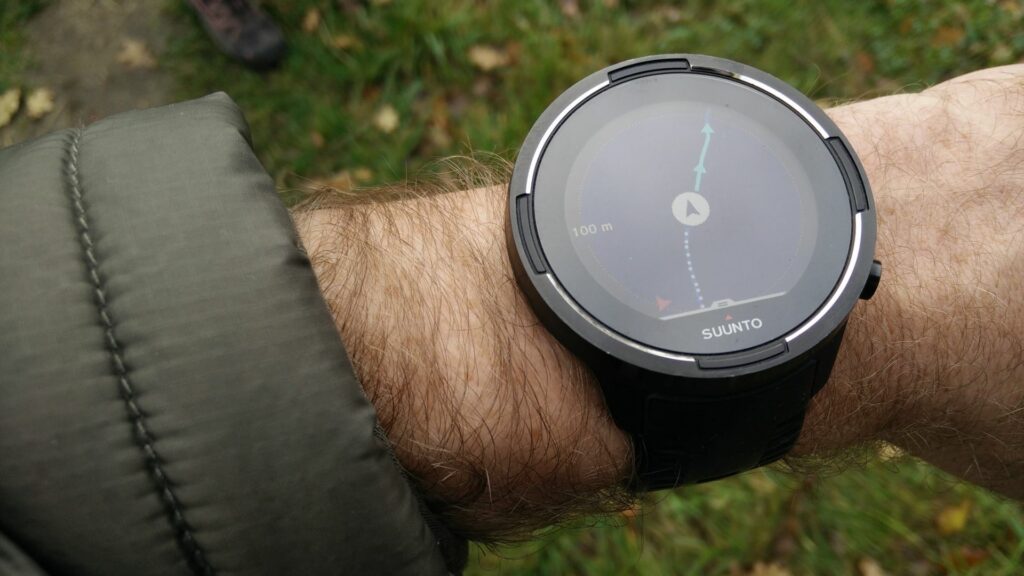
Hiking watches with GPS help you with the navigation
Most hiking watches support GPS which is currently the best solution for navigation and tracking. Some GPS watches also support alternative positioning systems like GLONASS, Galileo etc. A GPS watch allows you to instantly get the coordinates of your current location. Furthermore, it can also show current speed, distance, ascent, descent, and other GPS-based information. You can import routes in GPX or similar formats to most GPS watches. These routes can then be used for navigation as the watch shows your current location in relation to the GPX route.
GPS watches also track (record) your activities and allow you to export the details (duration, distance, average speed, total ascent, total descent and other parameters) to web or mobile apps such as Suunto App or Garmin Connect for analysis. However, GPS watches have a shorter battery life than watches without GPS. This downside is somewhat mitigated by GPS watches being equipped with rechargeable batteries. On off the grid backpacking trips, a solar charger enables you to recharge your GPS watch.
Durability and Weight
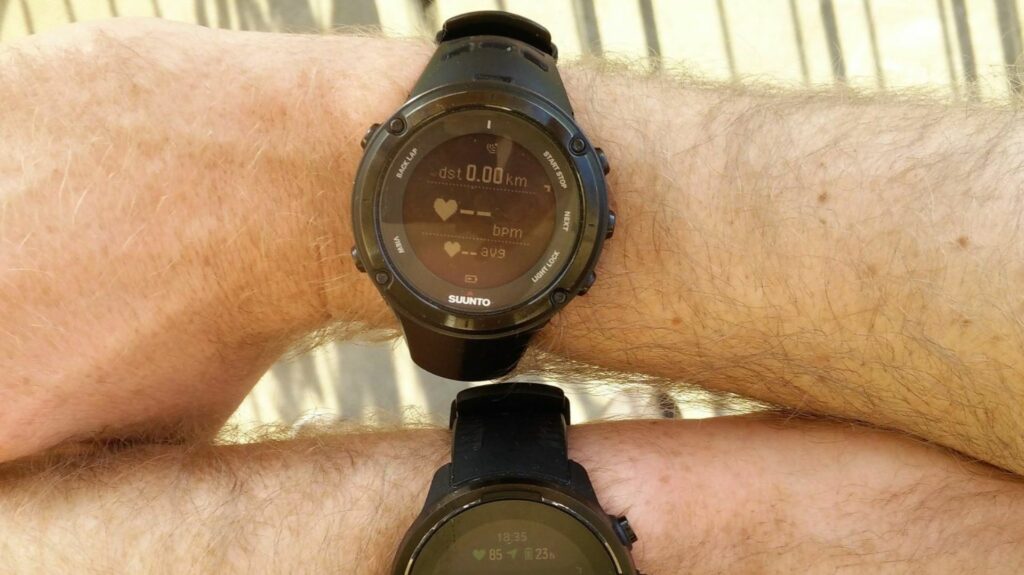
Durability and Weight: Watch for hiking must be robust and sturdy
A hiking watch must be sturdy and robust. However, the watch also shouldn’t be too heavy so you can wear it comfortably for longer periods. Therefore, hiking watches are typically made of fiber-reinforced polymers and sometimes feature a rear cover made of metal. The straps are typically made of silicone and less often from textile. Textile straps are harder to maintain because they must be washed regularly in order not to get smelly. Some watches come with Sapphire glass lenses for increased resistance against scratches. Sapphire glass provides superior scratch resistance in comparison to the more common mineral crystal. However, watches with Sapphire glass lenses are also significantly more expensive. Therefore, Sapphire glass is often an optional feature.
Heart Rate Monitor
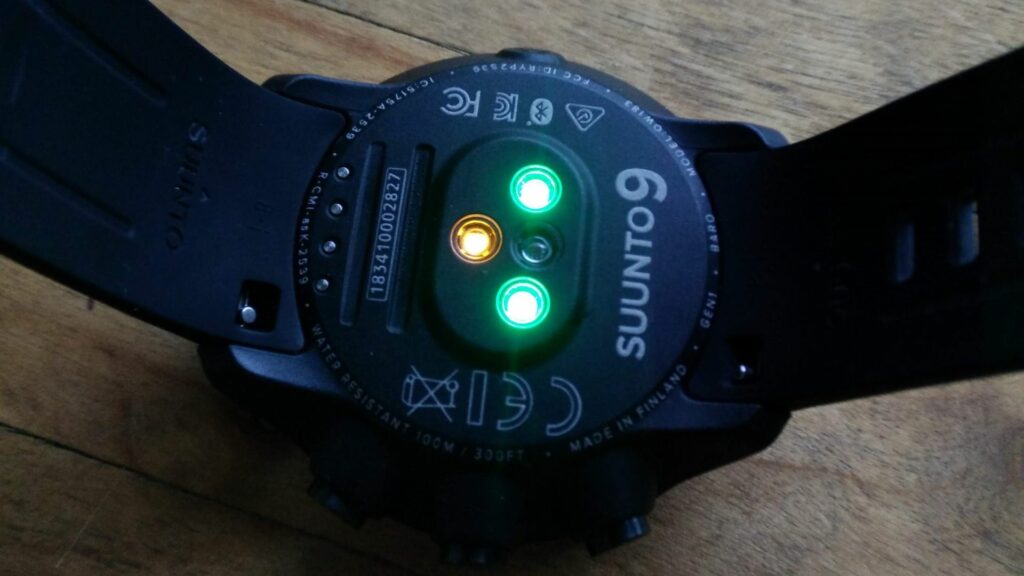
Heart Rate Monitor: New hiking watches are equipped with wrist heart rate monitors
Many hiking watches come with heart rate monitor functionality. Thereby, the watch can be connected to chest strap heart rate monitor which transfer heart rate data to the watch. Premium models of hiking watches have wrist heart rate monitors in addition to the option to connect a chest strap heart rate monitor. A wrist based heart rate monitor don’t require any extra device as they are part of the watch. They measure heart rate directly on your wrist by shining light into your blood vessels and detecting changes in blood volume. Wrist heart rate monitors are surprisingly accurate except for activities that involve a lot of pressure on hands (weightlifting, biking and such). Read more about the accuracy of wrist-based heart rate monitors here.
Connectivity
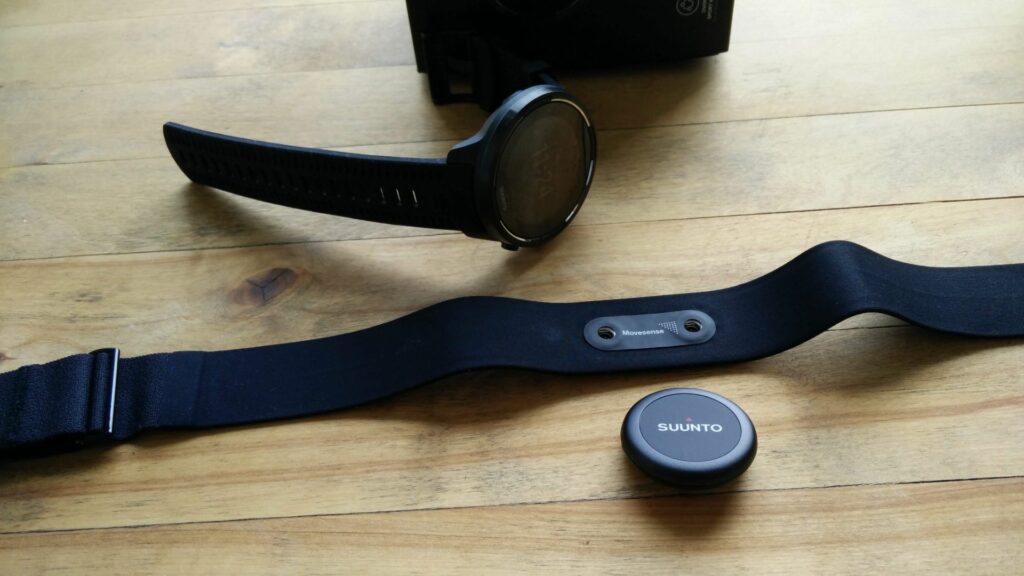
Connectivity: Bluetooth allows you to connect external devices such as chest strap heart rate monitor on the image above
Most hiking watches can be connected to external devices such as heart rate monitors, foot PODs, temperature sensors, smartphones and even action cameras. Three protocols are used for connectivity: ANT+, Bluetooth and Wi-Fi. ANT+ is an outdated protocol which was widely used years ago. New watches typically don’t support ANT+. Nowadays, watches mostly employ Bluetooth for connectivity and some are also equipped with Wi-Fi. The Bluetooth chip is the most important because it enables you to connect the watch to your smartphone. The Smartphone can then work as an intermediate device through which the watch has access to the internet. Wi-Fi enabled watches such as Garmin Fenix 7 can connect directly to the internet without first connecting to your smartphone. That is useful for transferring large amount of data to the watch, such as music.
Battery Life and Battery Modes
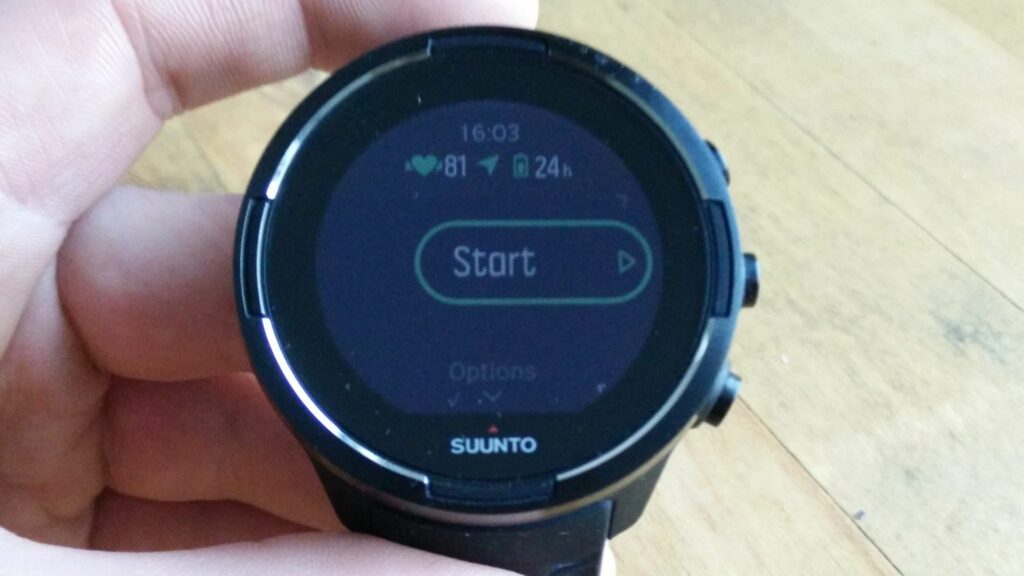
Battery Life: Battery of a GPS watch lasts for a few weeks in time mode but much less in GPS tracking mode
GPS watches are equipped with rechargeable batteries which last for up to two months in time mode. Nevertheless, a hiking watch is rarely used only for checking time and thus the battery life is much shorter in practice. The GPS and wrist HR features put the most strain on the battery. The battery of a hiking watch rarely last more than 30 hours in GPS mode (high accuracy). Nevertheless, most watches allow you to choose different battery modes for GPS tracking. For example, Suunto 9 has four battery modes: Performance, Endurance, Ultra and Tour. The Tour mode delivers up to 170 hours of GPS tracking time which is indeed great.
Watches without GPS use replaceable batteries which typically last for around a year, depending on the use of the watch.
Sunrise and Sunset Times
Sunrise and sunset times are not a must be they are useful because chances are that you’ll forget to check this before heading out. Knowing when the sun goes down enables you to return back before the nightfall and thus keeps you safe.
Interface
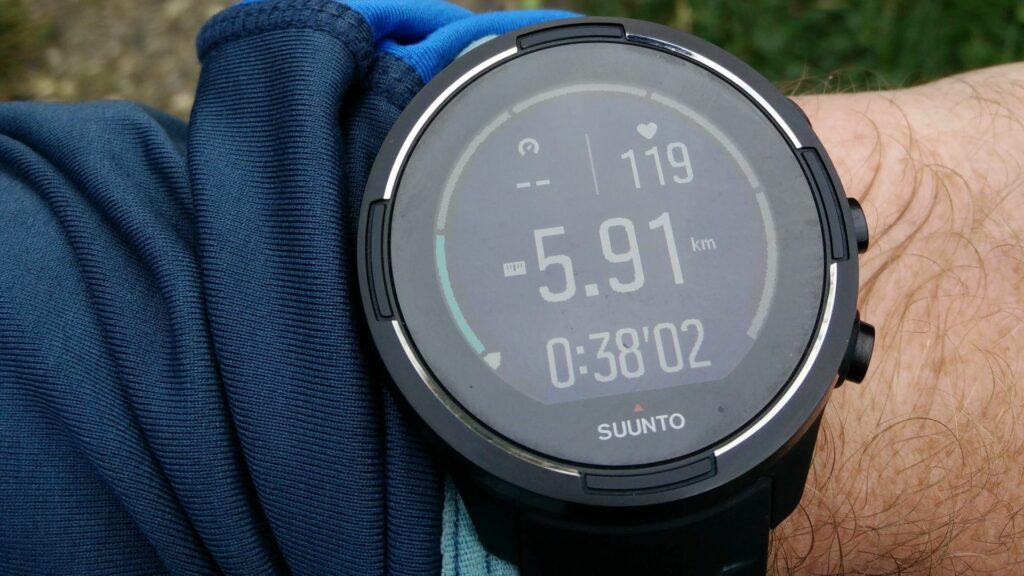
Interface: It’s important that the watch has buttons so you can use with sweaty hands and gloves
Watches are either equipped with a touch screen, buttons or both. Watches that only have a touch screen are not the best option for hiking and sports because they are hard to use with gloves, in rainy weather and with sweaty hands. Therefore, most sports watches are equipped with both buttons and touch screen. During activities the touch screen is usually locked so that the watch doesn’t trigger by the touch of clothes, gloves etc.
